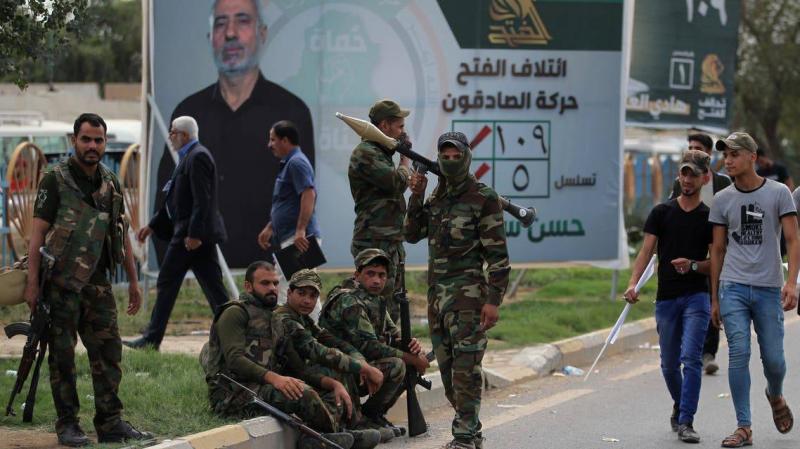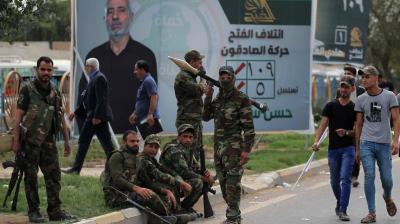Under the title "In Detail: Changes in Militia Operations in Iraq and the Secret of Drones," the Arabic website reported that with the rise in attacks by Iraqi militias against U.S. forces in Iraq and Syria over the past few weeks, it has been noteworthy that there is a shift in the operational strategy of these factions by adopting a dual attack approach (rockets and drones) simultaneously. This tactic aims to confuse the defensive systems in monitoring and responding to both types of attacks at the same time. What is the reality occurring in Iraq lately? What do the rocket and aerial attacks via drones, such as the recent attack on Ain al-Assad Airbase housing U.S. military personnel in Anbar province, mean?
Emerging cells and phantom attacks
In this context, Iraqi researcher Firas Elias, an expert in strategic affairs and national security, stated in an interview with "Al Arabiya.net" that "the integration of drone warfare in the ongoing conflict in Iraq aims to absorb the shock factor exerted by the United States in Iraq." He explained that "what is significant in these attacks is that they are claimed by emerging cells that are unknown, as if they are phantom attacks." He mentioned that Washington has started to operate the Dedrone system to shoot down drones after it became evident that the drones targeting its facilities are suicide drones with a single mission.
He added that "the recent shift in the operational strategy of these armed factions, specifically the attacking cells linked to them structurally, administratively, and ideologically (even though there are no clear features today regarding the nature of this connection), resulted from several reasons, the most prominent of which are the effectiveness of the C-RAM air defense systems introduced by the U.S. administration to contain the rockets, in addition to the significant gap created by the death of Qassem Soleimani, commander of the Quds Force, in the Iraqi arena, as he was the conductor of these factions in terms of either calming or escalating actions against the Americans.”
Transition to Decentralization
He continued, "Thus, it was necessary to find other means to fill the strategic gap that Soleimani was establishing in Iraq and to give greater momentum to the new Quds Force commander, Esmail Qaani. Here, we began to see an uptick in drone attacks as well as attacks on logistical support lists via explosive devices, alongside a new political discourse that aligns with the political transformation occurring in the Afghan arena, attempting to replicate this model in Iraq."
Elias, who recently published a book titled "The Centrality of Iraq in the Iranian Strategic Depth," said, "There was a centralization in decision-making and strategic action for the armed factions when Soleimani was present, but his absence has caused a new shift in the Quds Force's thinking in Iraq, transitioning from a centralized working method to decentralization. The relationship shifted from the Quds Force with the armed factions to the armed factions with emerging cells, providing them with a margin of independence in movement without having to refer back to the Quds Force except for fundamental and crucial matters."
However, this new strategy has not met the hopes of Esmail Qaani, according to Elias, as his repeated visits to Iraq have failed to regulate these factions. The decentralization has also produced a state of rebellion among faction leaders, leading to conflict among them to establish their superiority in front of Iranian officials, with conflicts emerging between Qais al-Khazali, Akram al-Kaabi, and Hadi al-Amiri.
Three Iranian Entities in the Iraqi Scene
He also clarified that "the Iraqi file was monopolized by the Revolutionary Guard represented by the Quds Force and its commander, but after Soleimani's assassination and the subsequent failures of the Iranian role in Iraq, other Iranian institutions have entered the Iraqi scene, including the Iranian Foreign Ministry, the Intelligence Service, and the Quds Force."
With the developments in the new Iranian scene under hardliner President Ibrahim Raisi, a series of changes will occur in the functioning of the allied Iraqi factions and in regulating their "disputes." In this context, the Iraqi researcher considered that "Raisi's rise to power will create a state of unity regarding the political discourse and Iranian policies in Iraq. Three Iranian institutions will operate according to the Supreme Leader's directives: the hardline Iranian president, the hardline Parliament Speaker, and the Revolutionary Guard, which means we will witness a unified Iranian policy in Iraq, after having witnessed two discourses: one diplomatic represented by Hassan Rouhani and another escalatory represented by the Revolutionary Guard."
Competition between Qaani and Hajazi
Before Raisi's victory, there was competition between two influential Iranian figures in Iraq: Esmail Qaani, commander of the Quds Force, and Asghar Hajazi, the military office director for Supreme Leader Ali Khamenei and head of the Iraqi resistance coordination committee.
In this framework, Elias spoke about "two armed entities in Iraq: the coordination committee for the resistance affiliated with Hajazi, i.e., with the Supreme Leader's office, and the Iraqi Hezbollah brigades that follow it, as well as the factions of the resistance axis that follow the Iranian Quds Force, but with Raisi's ascent to power, the competition between these two entities will end."
Role of Hezbollah
As for the role of Hezbollah in enhancing the capabilities of the armed factions, Dr. Firas Elias considered that "it is the logistical supporter and strategic depth for all Iranian-affiliated armed factions in the region, and it has played a major role in restructuring those factions, both in combat and in sending advisors to Iraq specifically to oversee training on the use of drones and conducting psychological warfare and rockets, especially 107 mm."
He also discussed the role of Mohammed Kawtharani, the person responsible for the Iraqi file in Hezbollah, along with the late leader Imad Mughniyeh, who is emulated by many Iraqi factions.
Since the beginning of the year, over 40 attacks have targeted U.S. interests in Iraq, including the embassy in Baghdad, Iraqi military bases housing Americans, the airports of Baghdad and Erbil, along with logistical convoys for the international coalition against ISIS led by Washington.




